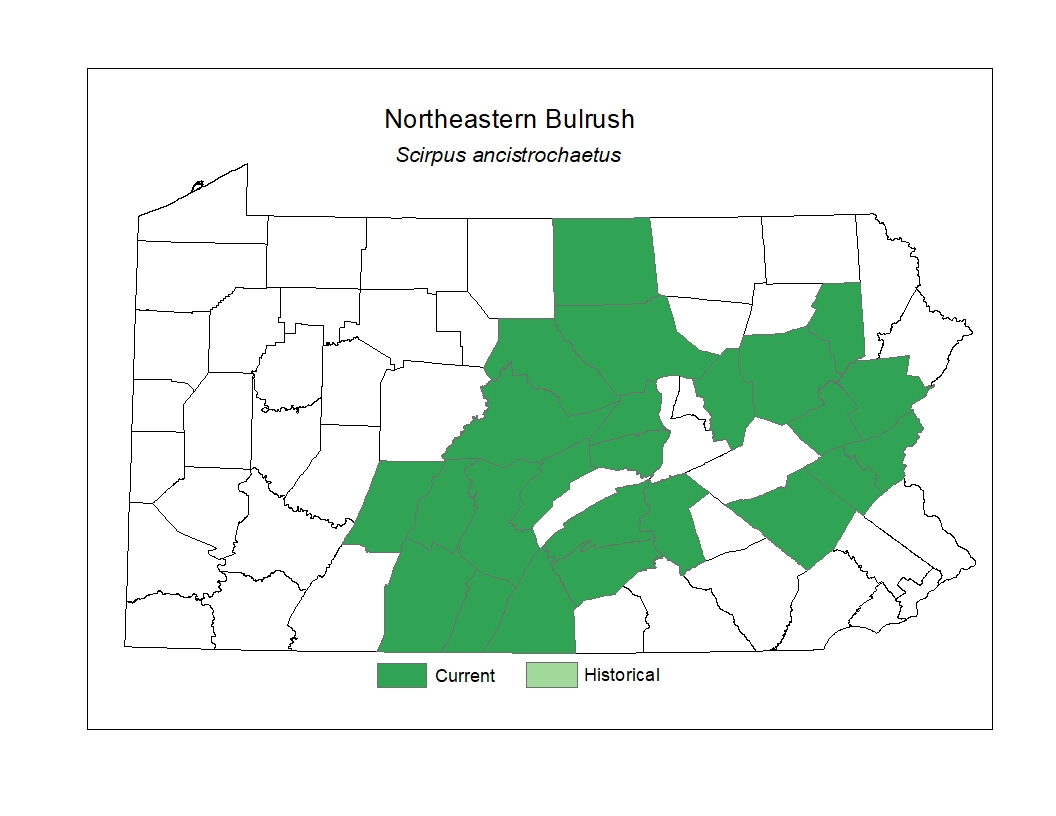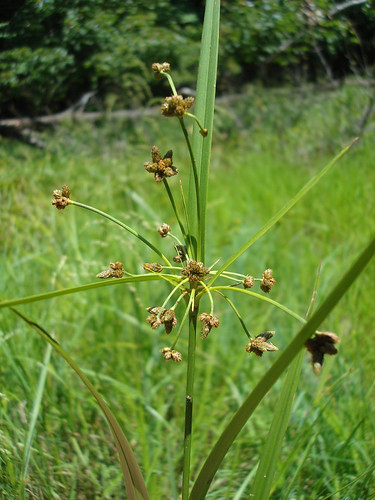 Species Factsheets
Species Factsheets
Scirpus ancistrochaetus
Northeastern Bulrush
State Status: Pennsylvania Endangered (PE)
PBS Status: Pennsylvania Threatened (PT)
Federal Status: LE
Global Rank: G3
![]() rank interpretation
rank interpretation
State Rank: S3
Did You Know?
Not too much is known about this species because it is hard to not only find but recongize when you are in its habitat.
Description
Northeastern bulrush (Scirpus ancistrochaetus) is a tall sedge with short thick underground rhizomes from where the leaves emerge in May. Superficially, sedges seem to be “grass like” plants; however, there are many differences between sedges and grasses. With practice, the two families are easily distinguished from each other. Leaves are three-angled, narrow, green to whitish or brown, and have basal sheaths. Flowers are individually difficult to see without magnification. The grouping of flowers or the inflorescences are more obvious, sometimes resembling the exploding of a fire work. The branches holding the inflorescence droop with age. The fruits, or achenes in this case, are very small, less than half a cm across.
Rank Justification
Vulnerable in the nation or state due to a restricted range, relatively few populations (often 80 or fewer), recent and widespread declines, or other factors making it vulnerable to extirpation.
Habitat
Throughout its range including in Pennsylvania, it is found growing on the edges of seasonal pools, wet depressions, beaver ponds, wetlands, and small ponds.
Survey Dates
Fruits in July; flower structures with achenes through January
Distribution

Threats
Only sixty or so populations exist throughout its entire range. Pennsylvania has the largest number of occurrences. The decline of this species is attributed to multiple threats: degradation of habitat from road construction and upland runoff, destruction by off road vehicles, and conversion of land for other uses.
Management
Slight variations in the natural fluctuation in the water level can harm this plant. Therefore, activities that impact the water table and degrade the plant's habitat such as development, ATV use, agriculture, quarrying, and dredging have been known to destroy several historic locations. Other potential threats to the species include deer browsing, fire, and natural succession.
Conservation Status Map

NatureServe. 2017. NatureServe Explorer: An online encyclopedia of life [web application]. Version 7.1. NatureServe, Arlington, Virginia. Available https://explorer.natureserve.org.
https://www.fws.gov/northeast/pdf/bulrush.pdf
- NatureServe. 2018. NatureServe Explorer: An online encyclopedia of life [web application]. Version 7.1. NatureServe, Arlington, Virginia. Available at https://www.natureserve.org/explorer
- Pennsylvania Natural Heritage Program. 2018.
- Rhoads, A.F. and W.M. Klein, Jr. 1993. The Vascular Flora of Pennsylvania. American Philosophical Society, Philadelphia, Pennsylvania. Rhoads, A.F. and T.A. Block.
- 2007. The Plants of Pennsylvania: An Illustrated Manual. 2nd edition. University of Pennsylvania Press, Philadelphia, Pennsylvania.







